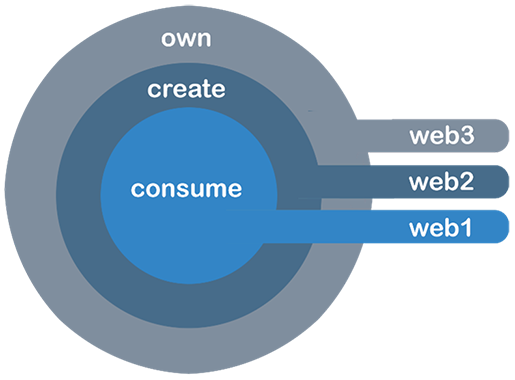.jpg?sfvrsn=19469200_2)
Unsurprisingly, I get asked “What is Web3?” a lot these days along with "What happened to blockchain?," "What is the metaverse?," and "Are NFTs legit?"
Before we answer these questions, let me pose another one: Why should you care about any of it? There are several possible scenarios where MSPs, technology vendors, integrators, et al, will need to deal with Web3, metaverse, NFTs, etc. (which I will group under “Web3 technologies” from now on):
- Your client asks, “What is Web3 (or metaverse, NFT, etc.)?” In this case, you will want to be knowledgeable to maintain your credibility with your client.
- A customer says, “I want to do something in Web3. What can we do?” You are going to want to speak knowledgeably on how their request fits within their business goals, roadmap, model, etc., where Web3 can benefit them, and what are the next steps to exploring the concept.
- Your client is required by one of their business partners or customers to be part of a decentralized (i.e., blockchain or Web3) system. You will want to know enough to hit the ground running to support your client, which may require spinning up a blockchain node for the shared system, connecting blockchain wallets, etc.
So, let me answer the above questions as best they can be.
What is Web3?
No one knows exactly what Web3 is or will be, yet. First, the terms “Web1” and “Web2” only came into common use recently and were defined in hindsight, so we’re probably a few years, or decades, away from truly understanding what Web3 really is (was), mostly likely when we are on the precipice of Web4. Second, there is an implication in those terms that each subsequent iteration of the web replaced the previous, which could not be further from the truth. Each iteration built on the previous, adding more features and function.

Related Content: How Web3 Could Change the Internet | Trend Watch
What Happened to Blockchain?
Well, nothing. The term is simply diminishing in popularity and being replaced by Web3 and NFTs. Many of us in the blockchain space predicted this years ago. Blockchain is a foundational technology. It is used for applications where a decentralized ledger is a good fit. It makes as much sense to be talking about blockchain as it does about TCP/IP or HTTPS. NFTs, for example, are simply a blockchain use case. Blockchain is taking its correct place in the application backend, like other databases such as MSSQL, rather than front and center as it has been.
What Is the Metaverse?
This is another loosely defined term. Any virtual experience, in other words a place or content that can only be experienced via technology (e.g., VR goggles, AR via a phone’s camera, or even just a web browser) can arguably be called part of a metaverse. In these early days, frankly, it’s a mess. Everyone is either creating their own metaverse (e.g., Meta) or staking claims in others (e.g., Gucci in The Sandbox). I believe this will shake out in one, or both, of the following ways:
- The shopping mall paradigm—brands will open small spaces in many metaverses.
- The theme park paradigm—brands will create their own metaverses and interoperable connections will be made to allow users to “travel” among them.
Are NFTs legit?
Yes, but the current art- or profile picture-based craze will die down. There is still some value for those use cases, but it is clear that they are currently massively overvalued and are already crashing down to earth (check out what happened with Jack Dorsey’s first Tweet). NFT stands for non-fungible token. All that means is that they are limited in number and exchange rates with other tokens cannot be established.
Think of fungible tokens like real currency where there is always an exchange rate with another currency (e.g., USD to Euros) and NFTs as items, such as cars. There are many Honda Civics out there, but there is no exchange rate between Honda Civics and BMW 5-series (imaging being able to exchange 2.2 Civics for a BMW, ha!).
There are many business cases for NFTs, including tokenizing assets, document management, identity, etc. Ultimately, those will be what survive, as well as many others that haven’t been created yet.
What Should I Do Next?
A few next steps for anyone interested in getting up to speed on Web3 technologies:
- Read/watch all the collateral on CompTIA’s Blockchain Advisory Council page
- Read/watch/listen to everything you can on Medium, YouTube, podcasts, etc. Some suggestions:
- Subscribe to some newsletters. A couple of suggestions:
- Follow some knowledgeable voices on LinkedIn. A few suggestions:
- Peter Huang - https://www.linkedin.com/in/petehuang/
- Susana Esteban - https://www.linkedin.com/in/susana-esteban/
- Charles Adkins - https://www.linkedin.com/in/charlesxadkins/
Be warned, you will find lots of contradictory information. As I said above, neither Web3 nor metaverse are settled subjects, nor are the best use cases for blockchain. However, the wide and varied perspectives can be very useful when speaking with your customers. If they come with some unformed or poorly thought-out concepts, you will have seen enough to know when more due diligence is necessary to determine whether Web3 technologies are necessary for their use case.
If you want to dive in deeper, take some classes on blockchain for business and read up on permissioned blockchain products to learn how they are widely used for business applications. Lastly, of course, you can hire a consultant for either general knowledge or a specific use case.
Adam Lesh is founder and CTO of The Maker Foundry and co-chair of CompTIA’s Blockchain Advisory Council.
Looking to connect with more blockchain solutions providers?
Join CompTIA's Blockchain Technology Interest Group!

 Add CompTIA to your favorite RSS reader
Add CompTIA to your favorite RSS reader

